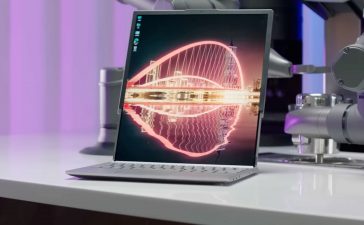The first M3 benchmark figures are showing up, which means it’s a good time to look at why (and how) Apple already won the processor wars.
Apple introduced the first three members of its M3 processor family this week: M3, M3 Pro, M3 Max. The M3 Ultra may show later if the company feels there is demand. We’ve also seen the first claimed Geekbench benchmarks for two of these chips:
- M3 chip: Single-core performance of 3,030 and multi-core performance of 11,694.
- M3 Max: Single-core performance of roughly 3,000 and multi-core performance of around 21,000.
Don’t jump in the lake
It is important to note that this degree of performance is being achieved in computers that use just 50 watts of power at peak performance, deliver 100% performance for up to 18 hours when using a battery, and barely get warm.
The chips already seem superior to Intel’s 16-core Meteor Lake processors, which top out at around 13,000 multicore, but use more energy. Apple’s new chips also raise the bar against Qualcomm, which just last week introduced a processor that almost competes with Apple’s now old M2 processors.
Sure, while you will find more performant chips, these won’t fit in the same slim Mac chassis, generally use much more energy, and cost a lot to obtain.
Here’s how Apple’s processors stack up against each other:
- M3: 3,030 single-core, 11,694 multi-core.
- M2: 2,570 single-core, 9,600 multi-core.
- M1: 1,690 single-core, 7,304 multi-core.
- M3 Max: around 3,000 single-core, around 21,000 multi-core.
- M2 Max: 2,736 single-core, 14,495 multi-core.
- M1 Max: 2,376 single-core,12,185 multi-core.
- M3 Pro not yet known.
(Test data sometimes varies, but these figures should be relatively accurate guides.)
From the data, you can see that an entry-level MacBook Pro with an M3 chip now offers about as much benchmark performance as you got from a 14-in. MacBook Pro running the M2 Pro, while the M3 Max seemingly eclipses the highest-end M2 Ultra Mac Studio.
That’s a lazy comparison, of course, as the number of active cores in different Macs varies and there are other factors that come into play. But it does help put things into perspective.
Ever since Apple introduced the M-series chips, the company has effectively been competing against itself.
One huge step for Mac-kind
Here are three reasons why it will continue to do so:
-
Margins: Apple takes the same essential processor design and iterates it across its products. That means that when it comes to building the processor ,many features can be shared across iPhones, iPads, Macs, even Apple TV. It then iterates for each product family. The M5 processor Apple is almost certainly developing now will see its R&D budget paid for by future sales of hundreds of thousands of products that carry it. Apple doesn’t dominate in any of these categories, but the company is highly profitable, and its products sell in quantity. That means that Apple now gets to spend more on processor development than competitors like Qualcomm, Intel, or others. While the latter companies may recoup their investments by sales across multiple customers, they don’t necessarily enjoy the integrated advantages of Apple Silicon design.
-
Markets: Remember all those stories about PC and smartphone market weakness? They are all true, and we know every vendor is affected, including Apple. At the same time, statistical anomalies aside, Apple is actually seeing its market share relative to competitors go up, even as others decline. Look, if you’re a boutique chip vendor, it matters that Windows’ share fell around 10% in the last year. It matters that Mac now accounts for about 20% of the global market. Each additional Apple product sale helps meet the processor design bill. Each lost Windows sale reduces investment in the next generation PC chip as it cuts into margins across that ecosystem. It means Apple can continue to outspend competitors on processor development. Other PC makers can’t easily match this, with the possible exception of Samsung. Huawei might get there, but faces other problems addressing global markets.
-
Models: PC processor developers compete against each other for sales. Intel, Qualcomm, AMD — all try to convince PC and smartphone makers to use their chips. Competition is fierce, and as markets shrink and money gets tighter, players in that game face real pressure on price. New entrants into the space have a big impact on markets and margins. Eventually some of these vendors will begin to reduce their profit margins to generate a sale; that’s when the overall processor industry enters a price war. We’ve seen this happen before in the once-flourishing Android and tablet markets — once price competition intensified, mergers, acquisitions, and exits began. These days, a handful of players dominate the space, many competing in the low-end, price-conscious zone Apple (bar the second user market) leaves behind. This will happen again in processor design. Apple will continue to generate the profit it needs to continue to maintain intensive processor innovation and still enjoy a seriously healthy business. Competitors will have to work much harder and can’t possibly make the financial investment required to tackle the “whole widget” company.
The M4 processor
I’m fairly certain Apple’s silicon teams are already thinking about the M5 and later processors. With this in mind, it is interesting how little speculation has yet emerged concerning its future Mac chips. When it came to the M3, everyone knew that Apple was going to move to 3nm process design. TSMC had said it was working towards this and Apple is its biggest customer, so it wasn’t terribly hard to join the dots.
So, what’s the next big thing on TSMC’s chip development road map? An Anandtech report hints that the main focus will be performance and battery life tweaks with several iterations planned. Each iteration of these 3nm processors will deliver performance and energy consumption improvements, while the density of transistors will also increase.
(This is why Apple is beginning to talk about those numbers — there are 25 billion transistors on the M3, growing to 92 billion on the M3 Max. Watch those figures grow in the coming three years.)
TSMC is also working toward a 2-nanometer process by 2025.
That may slip, and it’s doubtful these processors will be ready to ship in huge quantity for a while, which suggests both Apple’s M4 and M5 processor families will be iterations on the same 3nm process. That’s not really a problem, given that right now Apple is the only PC manufacturer offering systems built on 3nm chips to the mass market. It will almost certainly use its financial muscle and huge R&D investment to ensure it continues to offer better chips at prices competitors can’t matc,h and seems on track to continue to deliver the kind of performance gains we’ve already seen across the first successive generations of M-series chips.
To put some very highly speculative guesstimates around all of this, based on what I’ve been reading in TSMC road maps, I’m willing to imagine the basic M5 processor used in an entry-level Mac mini (whenever that appears) may match or exceed M3 Max performance in multicore tests. You really can’t ignore the massive leap encapsulated in a road map like that.
One more thing
No wonder Apple execs were smiling when Craig Federighi admitted in 2020 that the company “overshot” when it developed Apple Silicon for Macs. “This one, part of what has us all just bouncing off the walls here — just smiling — is that as we brought the pieces together, we’re like, ‘This is working better than we even thought it would.”
So this is why Apple has, will, and can continue to win the processor wars — and should make Statcounter data interesting reading for some time to come. Can anyone else hear an echo of Apple Vice President Phil Schiller’s famous line concerning Apple innovation in Macs? It looks like he may grab the last laugh after all….
Please follow me on Mastodon, or join me in the AppleHolic’s bar & grill and Apple Discussions groups on MeWe.
Copyright © 2023 IDG Communications, Inc.










